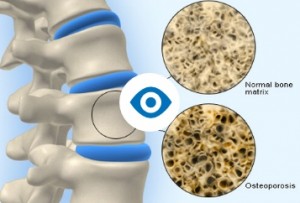Osteoporosis is a condition marked by decreased bone density, which results in lower bone strength and higher fragility. In this condition, bones become abnormally porous and compressible, like a sponge.
Osteoporosis greatly weakens the bones and results in frequent fractures. These fractures typically occur in the hip, wrist or spine.

What is Osteopenia?
Osteopenia is a bone condition where the density reduces slightly. The density in this condition is lesser than a normal bone but not as less as osteoporosis. Osteopenia often leads to osteoporosis, when left unchecked.
A person is often not aware that he or she has osteoporosis until a fracture occurs. But there are occasionally symptoms of the disorder. They could include:
Most factors that govern your risk of osteoporosis are outside your control. For example, women are much more likely to develop osteoporosis. Also, the risk of osteoporosis increases with age. Besides these uncontrollable factors, controllable reasons like dietary factors and intake of certain medicines are also associated with osteoporosis. For example, low calcium intake or general eating disorders greatly increase the risk of osteoporosis.
A simple test which is commonly available called Bone Mineral Density (BMD) Measurement can help detect the presence of osteopenia or osteoporosis.
Treatment of Osteoporosis
Medication and Pharmacotherapy: In osteopenia and early-stage osteoporosis, oral medicines are the most common treatment to control the problem. These medicines fall under the category of bisphosphonates. Examples of these medicines include Alendronate, Risedronate and Ibandronate.
You can also book an appointment over phone by calling us on +8801944-000999 or Here Online !
© 2023 Ava Pain & Intervention Center(APIC) | All rights reserved | Design & Development By-